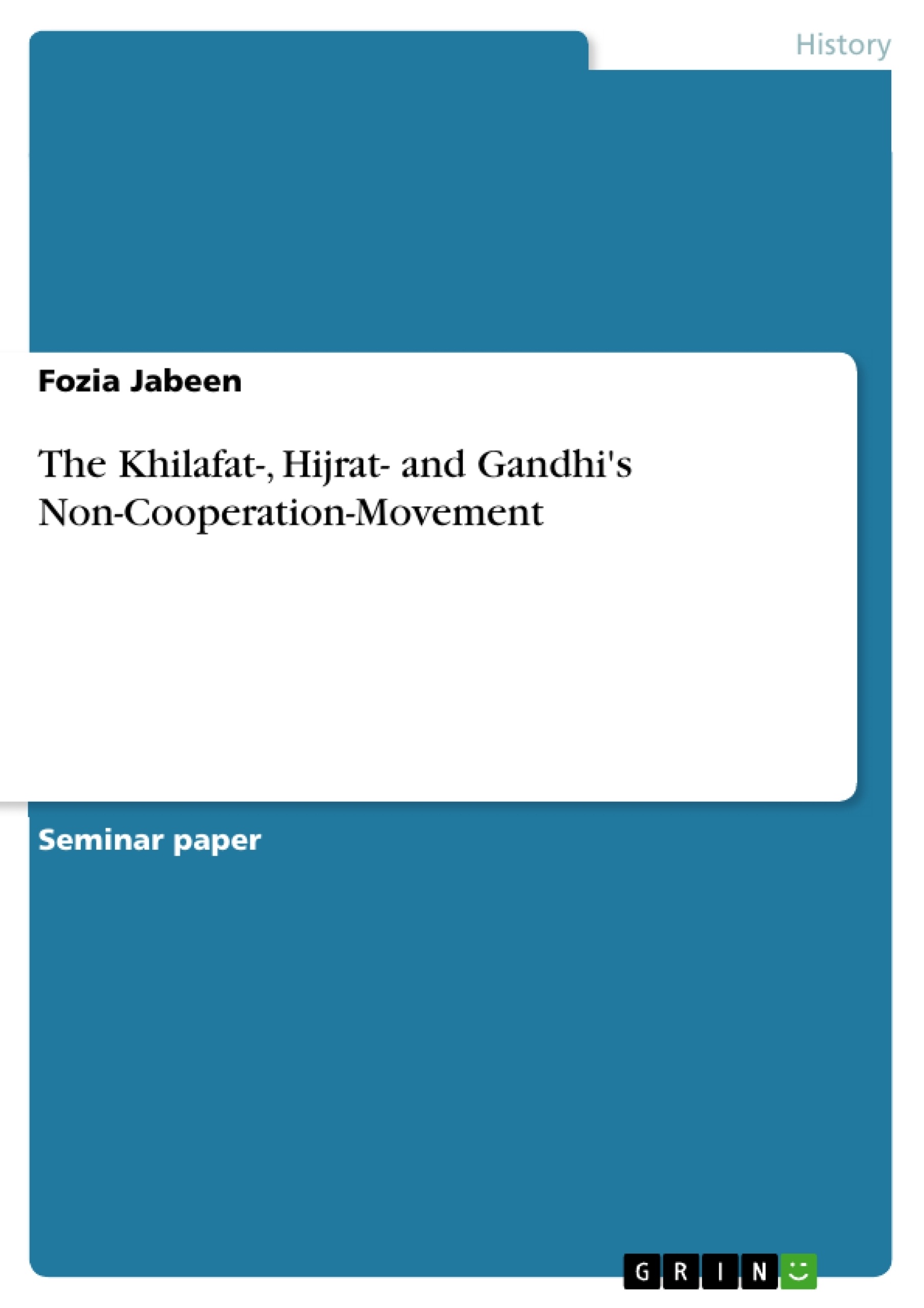The Khilafat Movement was the first ripple in the stagnant ocean of Muslim politics in India. The movement combined them as a nation and gave them a good lesson of unity. Seeing the opportunity, Mahatma Gandhi quickly affiliated himself with the Khilafat movement. The Khilafat movement enabled Gandhi to spread his non-cooperation movement in the whole country of India. One byproduct of the Khilafat movement was the Hijrat movement. The Hijrat movement failed, affecting the financial condition of Muslims badly, but conveying their unstinted love for Islam. The Khilafat movement was unable to achieve its targets, but the political activity it created helped Muslims to organize themselves as a nation and to work systematically in the upcoming movement of independence from India.
Table of Contents
- Introduction
- Start of the Movement
- The Entry of Gandhi and Non-Cooperation Movement
- The Hijrat Movement
- Conclusion
Objectives and Key Themes
This text aims to explore the Khilafat Movement in British India, analyzing its origins, key players, and impact on the broader political landscape. It examines the movement's role in fostering Muslim unity and its connection to Mahatma Gandhi's non-cooperation movement. The text also investigates the failed Hijrat movement and its consequences.
- The origins and development of the Khilafat Movement.
- The relationship between the Khilafat Movement and the Non-Cooperation Movement.
- The role of key figures like Mahatma Gandhi and the Ali brothers.
- The impact of the failed Hijrat Movement.
- The long-term consequences of the Khilafat Movement on Indian Muslim political organization.
Chapter Summaries
Introduction: This introductory chapter sets the stage for the Khilafat Movement by explaining the anxieties of Indian Muslims following World War I and the dismemberment of the Ottoman Empire. The loss of the Ottoman Caliphate, a symbol of Muslim power and unity, instilled a deep fear among Indian Muslims of losing their identity and political standing. The chapter highlights the broken promises of the British government, which failed to protect Turkish territories as it had pledged, furthering the discontent among the Muslim population and laying the groundwork for the movement's emergence.
Start of the Movement: This chapter details the escalation of the Khilafat Movement. It chronicles the growing dissatisfaction and worry among Indian Muslims due to the British government's disregard for their concerns about the Ottoman Empire's fate. The chapter describes the formation of the Khilafat Committee, the observance of Khilafat Day, and the internal divisions within the leadership regarding strategies – whether to pursue peaceful petitions or mass agitation. The chapter underscores the growing momentum of the movement and its ability to unite Muslims for a shared cause, despite internal disagreements.
Keywords
Khilafat Movement, Ottoman Empire, British India, Non-Cooperation Movement, Mahatma Gandhi, Muslim Unity, Hijrat Movement, Indian Independence, Political Organization.
Frequently Asked Questions: A Comprehensive Language Preview
What is the main topic of this text?
This text focuses on the Khilafat Movement in British India, exploring its origins, key players, and impact on the broader political landscape. It examines the movement's role in fostering Muslim unity and its connection to Mahatma Gandhi's non-cooperation movement, including the failed Hijrat movement and its consequences.
What are the key themes explored in the text?
Key themes include the origins and development of the Khilafat Movement; the relationship between the Khilafat Movement and the Non-Cooperation Movement; the role of key figures like Mahatma Gandhi and the Ali brothers; the impact of the failed Hijrat Movement; and the long-term consequences of the Khilafat Movement on Indian Muslim political organization.
What is covered in the Introduction chapter?
The introduction sets the context for the Khilafat Movement by explaining the anxieties of Indian Muslims after World War I and the disintegration of the Ottoman Empire. It highlights the loss of the Ottoman Caliphate as a symbol of Muslim power and the British government's broken promises regarding Turkish territories, which fueled discontent and laid the groundwork for the movement.
What does the "Start of the Movement" chapter discuss?
This chapter details the escalation of the Khilafat Movement, chronicling growing Muslim dissatisfaction with the British government's disregard for their concerns about the Ottoman Empire. It covers the formation of the Khilafat Committee, Khilafat Day, and internal divisions within the leadership regarding strategies, emphasizing the movement's ability to unite Muslims despite internal disagreements.
What are the key figures mentioned in the text?
The text mentions key figures such as Mahatma Gandhi and the Ali brothers as significant players in the Khilafat Movement and its interactions with the broader Indian political landscape.
What is the Hijrat Movement and its significance?
The text addresses the failed Hijrat movement, exploring its causes, consequences, and its relationship to the overall goals and impact of the Khilafat Movement.
What is the relationship between the Khilafat Movement and the Non-Cooperation Movement?
The text analyzes the connection and interplay between the Khilafat Movement and Mahatma Gandhi's Non-Cooperation Movement, highlighting their shared goals and strategies, as well as any points of divergence.
What are the long-term consequences of the Khilafat Movement?
The text examines the long-term effects of the Khilafat Movement on Indian Muslim political organization, its lasting impact on the political landscape of India, and its contribution to the larger struggle for Indian independence.
What keywords are associated with this text?
Keywords include: Khilafat Movement, Ottoman Empire, British India, Non-Cooperation Movement, Mahatma Gandhi, Muslim Unity, Hijrat Movement, Indian Independence, Political Organization.
What is the overall purpose of this text preview?
This preview provides a comprehensive overview of the text, including the table of contents, objectives, key themes, chapter summaries, and keywords, offering a structured and professional analysis of the Khilafat Movement.
- Quote paper
- Fozia Jabeen (Author), 2017, The Khilafat-, Hijrat- and Gandhi's Non-Cooperation-Movement, Munich, GRIN Verlag, https://www.hausarbeiten.de/document/366070



